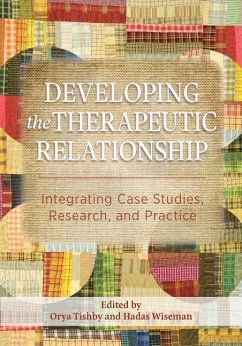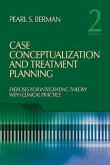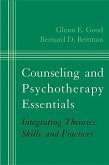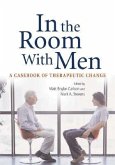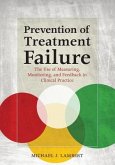Developing the Therapeutic Relationship: Integrating Case Studies, Research, and Practice
Herausgeber: Tishby, Orya; Wiseman, Hadas
Developing the Therapeutic Relationship: Integrating Case Studies, Research, and Practice
Herausgeber: Tishby, Orya; Wiseman, Hadas
- Gebundenes Buch
- Merkliste
- Auf die Merkliste
- Bewerten Bewerten
- Teilen
- Produkt teilen
- Produkterinnerung
- Produkterinnerung
In this book, master clinicians and psychotherapy researchers examine how technique and the therapeutic relationship are inseparably intertwined, and engaging case studies demonstrate how successful therapists negotiate this complex relationship.
Andere Kunden interessierten sich auch für
![Case Conceptualization and Treatment Planning: Integrating Theory with Clinical Practice Case Conceptualization and Treatment Planning: Integrating Theory with Clinical Practice]() Pearl S. BermanCase Conceptualization and Treatment Planning: Integrating Theory with Clinical Practice128,99 €
Pearl S. BermanCase Conceptualization and Treatment Planning: Integrating Theory with Clinical Practice128,99 €![Spirituality and the Therapeutic Process: A Comprehensive Resource from Intake to Termination Spirituality and the Therapeutic Process: A Comprehensive Resource from Intake to Termination]() Spirituality and the Therapeutic Process: A Comprehensive Resource from Intake to Termination72,99 €
Spirituality and the Therapeutic Process: A Comprehensive Resource from Intake to Termination72,99 €![Counseling and Psychotherapy Essentials: Integrating Theories, Skills, and Practices Counseling and Psychotherapy Essentials: Integrating Theories, Skills, and Practices]() Bernard D. BeitmanCounseling and Psychotherapy Essentials: Integrating Theories, Skills, and Practices55,99 €
Bernard D. BeitmanCounseling and Psychotherapy Essentials: Integrating Theories, Skills, and Practices55,99 €![In the Room with Men: Casebook of Therapeutic Change In the Room with Men: Casebook of Therapeutic Change]() In the Room with Men: Casebook of Therapeutic Change29,99 €
In the Room with Men: Casebook of Therapeutic Change29,99 €![Prevention of Treatment Failure: The Use of Measuring, Monitoring, and Feedback in Clinical Practice Prevention of Treatment Failure: The Use of Measuring, Monitoring, and Feedback in Clinical Practice]() Michael J. LambertPrevention of Treatment Failure: The Use of Measuring, Monitoring, and Feedback in Clinical Practice58,99 €
Michael J. LambertPrevention of Treatment Failure: The Use of Measuring, Monitoring, and Feedback in Clinical Practice58,99 €![The Human Elements of Psychotherapy: A Nonmedical Model of Emotional Healing The Human Elements of Psychotherapy: A Nonmedical Model of Emotional Healing]() David N. ElkinsThe Human Elements of Psychotherapy: A Nonmedical Model of Emotional Healing71,99 €
David N. ElkinsThe Human Elements of Psychotherapy: A Nonmedical Model of Emotional Healing71,99 €![Treatment Integrity: A Foundation for Evidence-Based Practice in Applied Psychology Treatment Integrity: A Foundation for Evidence-Based Practice in Applied Psychology]() Treatment Integrity: A Foundation for Evidence-Based Practice in Applied Psychology94,99 €
Treatment Integrity: A Foundation for Evidence-Based Practice in Applied Psychology94,99 €-
-
-
In this book, master clinicians and psychotherapy researchers examine how technique and the therapeutic relationship are inseparably intertwined, and engaging case studies demonstrate how successful therapists negotiate this complex relationship.
Hinweis: Dieser Artikel kann nur an eine deutsche Lieferadresse ausgeliefert werden.
Hinweis: Dieser Artikel kann nur an eine deutsche Lieferadresse ausgeliefert werden.
Produktdetails
- Produktdetails
- Verlag: American Psychological Association (APA)
- Seitenzahl: 360
- Erscheinungstermin: 26. Juni 2018
- Englisch
- Abmessung: 261mm x 181mm x 25mm
- Gewicht: 812g
- ISBN-13: 9781433829222
- ISBN-10: 1433829223
- Artikelnr.: 51258476
- Herstellerkennzeichnung
- Libri GmbH
- Europaallee 1
- 36244 Bad Hersfeld
- 06621 890
- Verlag: American Psychological Association (APA)
- Seitenzahl: 360
- Erscheinungstermin: 26. Juni 2018
- Englisch
- Abmessung: 261mm x 181mm x 25mm
- Gewicht: 812g
- ISBN-13: 9781433829222
- ISBN-10: 1433829223
- Artikelnr.: 51258476
- Herstellerkennzeichnung
- Libri GmbH
- Europaallee 1
- 36244 Bad Hersfeld
- 06621 890
Edited by Orya Tishby and Hadas Wiseman
Contents
Contributors
Introduction
Orya Tishby and Hadas Wiseman
Chapter 1: The Psychotherapy Relationship: Where Does the Alliance Fit?
Adam O. Horvath
Part I: The Case Studies: Integrating Research and Practice
Chapter 2: You Can’t Cross the Same River Twice: A Case Study of Alliance
Rupture and Repair
Laura Kohberger, Jeremy D. Safran, and J. Christopher Muran
Chapter 3: Patient and Therapist Relational Patterns: Implicit Negotiations
Emanuel Schattner and Orya Tishby
Chapter 4: Closeness and Distance Dynamics in the Therapeutic Relationship
Hadas Wiseman and Dana Atzil-Slonim
Chapter 5: Facilitating the Sense of Feeling Understood in Patients With
Maladaptive Relationships
Sigal Zilcha-Mano and Jacques P. Barber
Chapter 6: Clinical Choice Points and Professional Ethics in Psychoanalysis
Gaby Shefler
Chapter 7: The Therapeutic Relationship: A Warm, Important, and Potentially
Mutative Factor in Cognitive–Behavioral Therapy
Louis G. Castonguay, Soo Jeong Youn, Henry Xiao, and Andrew A. McAleavey
Chapter 8: Negotiating Multiple Roles and Stances in Cognitive–Behavioral
Therapy
Yoni Elizur and Jonathan D. Huppert
Chapter 9: Affirming the Case for Positive Regard
Barry A. Farber and Jessica Y. Suzuki
Chapter 10: Empathy and Responsiveness in Emotion-Focused Therapy
Jeanne C. Watson
Chapter 11: Where the Alliance and Systems Theory Meet in Brief Family
Therapy
Laurie Heatherington, Valentín Escudero, and Myrna L. Friedlander
Chapter 12: The Use of Immediacy in Supervisory Relationships
Clara E. Hill and Shudarshana Gupta
Part II: Mapping Models and Conclusions
Chapter 13: Mapping Models of the Therapeutic Relationship: Implications
for Integrative Practice
Stanley B. Messer and Daniel B. Fishman
Chapter 14: Conclusions: The Tapestry of the Therapeutic Relationship and
Recommendations for Clinicians and Researchers
Orya Tishby and Hadas Wiseman
Index
About the Editors
Contributors
Introduction
Orya Tishby and Hadas Wiseman
Chapter 1: The Psychotherapy Relationship: Where Does the Alliance Fit?
Adam O. Horvath
Part I: The Case Studies: Integrating Research and Practice
Chapter 2: You Can’t Cross the Same River Twice: A Case Study of Alliance
Rupture and Repair
Laura Kohberger, Jeremy D. Safran, and J. Christopher Muran
Chapter 3: Patient and Therapist Relational Patterns: Implicit Negotiations
Emanuel Schattner and Orya Tishby
Chapter 4: Closeness and Distance Dynamics in the Therapeutic Relationship
Hadas Wiseman and Dana Atzil-Slonim
Chapter 5: Facilitating the Sense of Feeling Understood in Patients With
Maladaptive Relationships
Sigal Zilcha-Mano and Jacques P. Barber
Chapter 6: Clinical Choice Points and Professional Ethics in Psychoanalysis
Gaby Shefler
Chapter 7: The Therapeutic Relationship: A Warm, Important, and Potentially
Mutative Factor in Cognitive–Behavioral Therapy
Louis G. Castonguay, Soo Jeong Youn, Henry Xiao, and Andrew A. McAleavey
Chapter 8: Negotiating Multiple Roles and Stances in Cognitive–Behavioral
Therapy
Yoni Elizur and Jonathan D. Huppert
Chapter 9: Affirming the Case for Positive Regard
Barry A. Farber and Jessica Y. Suzuki
Chapter 10: Empathy and Responsiveness in Emotion-Focused Therapy
Jeanne C. Watson
Chapter 11: Where the Alliance and Systems Theory Meet in Brief Family
Therapy
Laurie Heatherington, Valentín Escudero, and Myrna L. Friedlander
Chapter 12: The Use of Immediacy in Supervisory Relationships
Clara E. Hill and Shudarshana Gupta
Part II: Mapping Models and Conclusions
Chapter 13: Mapping Models of the Therapeutic Relationship: Implications
for Integrative Practice
Stanley B. Messer and Daniel B. Fishman
Chapter 14: Conclusions: The Tapestry of the Therapeutic Relationship and
Recommendations for Clinicians and Researchers
Orya Tishby and Hadas Wiseman
Index
About the Editors
Contents
Contributors
Introduction
Orya Tishby and Hadas Wiseman
Chapter 1: The Psychotherapy Relationship: Where Does the Alliance Fit?
Adam O. Horvath
Part I: The Case Studies: Integrating Research and Practice
Chapter 2: You Can’t Cross the Same River Twice: A Case Study of Alliance
Rupture and Repair
Laura Kohberger, Jeremy D. Safran, and J. Christopher Muran
Chapter 3: Patient and Therapist Relational Patterns: Implicit Negotiations
Emanuel Schattner and Orya Tishby
Chapter 4: Closeness and Distance Dynamics in the Therapeutic Relationship
Hadas Wiseman and Dana Atzil-Slonim
Chapter 5: Facilitating the Sense of Feeling Understood in Patients With
Maladaptive Relationships
Sigal Zilcha-Mano and Jacques P. Barber
Chapter 6: Clinical Choice Points and Professional Ethics in Psychoanalysis
Gaby Shefler
Chapter 7: The Therapeutic Relationship: A Warm, Important, and Potentially
Mutative Factor in Cognitive–Behavioral Therapy
Louis G. Castonguay, Soo Jeong Youn, Henry Xiao, and Andrew A. McAleavey
Chapter 8: Negotiating Multiple Roles and Stances in Cognitive–Behavioral
Therapy
Yoni Elizur and Jonathan D. Huppert
Chapter 9: Affirming the Case for Positive Regard
Barry A. Farber and Jessica Y. Suzuki
Chapter 10: Empathy and Responsiveness in Emotion-Focused Therapy
Jeanne C. Watson
Chapter 11: Where the Alliance and Systems Theory Meet in Brief Family
Therapy
Laurie Heatherington, Valentín Escudero, and Myrna L. Friedlander
Chapter 12: The Use of Immediacy in Supervisory Relationships
Clara E. Hill and Shudarshana Gupta
Part II: Mapping Models and Conclusions
Chapter 13: Mapping Models of the Therapeutic Relationship: Implications
for Integrative Practice
Stanley B. Messer and Daniel B. Fishman
Chapter 14: Conclusions: The Tapestry of the Therapeutic Relationship and
Recommendations for Clinicians and Researchers
Orya Tishby and Hadas Wiseman
Index
About the Editors
Contributors
Introduction
Orya Tishby and Hadas Wiseman
Chapter 1: The Psychotherapy Relationship: Where Does the Alliance Fit?
Adam O. Horvath
Part I: The Case Studies: Integrating Research and Practice
Chapter 2: You Can’t Cross the Same River Twice: A Case Study of Alliance
Rupture and Repair
Laura Kohberger, Jeremy D. Safran, and J. Christopher Muran
Chapter 3: Patient and Therapist Relational Patterns: Implicit Negotiations
Emanuel Schattner and Orya Tishby
Chapter 4: Closeness and Distance Dynamics in the Therapeutic Relationship
Hadas Wiseman and Dana Atzil-Slonim
Chapter 5: Facilitating the Sense of Feeling Understood in Patients With
Maladaptive Relationships
Sigal Zilcha-Mano and Jacques P. Barber
Chapter 6: Clinical Choice Points and Professional Ethics in Psychoanalysis
Gaby Shefler
Chapter 7: The Therapeutic Relationship: A Warm, Important, and Potentially
Mutative Factor in Cognitive–Behavioral Therapy
Louis G. Castonguay, Soo Jeong Youn, Henry Xiao, and Andrew A. McAleavey
Chapter 8: Negotiating Multiple Roles and Stances in Cognitive–Behavioral
Therapy
Yoni Elizur and Jonathan D. Huppert
Chapter 9: Affirming the Case for Positive Regard
Barry A. Farber and Jessica Y. Suzuki
Chapter 10: Empathy and Responsiveness in Emotion-Focused Therapy
Jeanne C. Watson
Chapter 11: Where the Alliance and Systems Theory Meet in Brief Family
Therapy
Laurie Heatherington, Valentín Escudero, and Myrna L. Friedlander
Chapter 12: The Use of Immediacy in Supervisory Relationships
Clara E. Hill and Shudarshana Gupta
Part II: Mapping Models and Conclusions
Chapter 13: Mapping Models of the Therapeutic Relationship: Implications
for Integrative Practice
Stanley B. Messer and Daniel B. Fishman
Chapter 14: Conclusions: The Tapestry of the Therapeutic Relationship and
Recommendations for Clinicians and Researchers
Orya Tishby and Hadas Wiseman
Index
About the Editors

